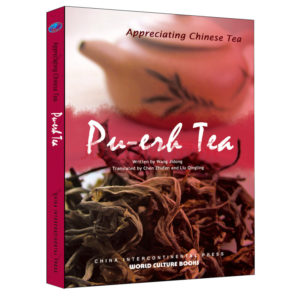Description
Matching Yunnan and Guangxi Tea Workshop
Author: Jidong Wang
Publishing house: China Intercontinental Press
Edition: 1 (Jan. 2010)
Page: 160
Format: 32
Preface:
You have to visit the virgin forests in southwest Yunnan to see the orginal ancient tea trees. Oblivious to the changing market economy, these trees remain unmoved, watching the mountian fog gathering and clearing all year round. Unlike young trees which flourish every season padding the tea farmers’ wallets, ancient trees slow down their growth, showing dignity. The phrase “tea from wild ancient trees” touches your heart, transporting you to the vast fields and remote mountians, offering tranquility.
Abstract:
Why is tea the National drink of China? Why is tea regarded as symbolizing the harmony and mysterious unity of the Universe? Why is the loose-leaf Chinese tea more beneficial than the tea bags? How many types of Chinese tea are Available? How to make the best cup of Chinese tea? ……A visitor to the home of tea has so many questions. Understanding their answers will bring you closer to the history and mystery of tea. Appreciating Chinese Tea Series will help you.
Content:
Part1 Learning about Pu-erh Tea from Its Processing Techniques
Part2 Classification of Pu-erh Tea
Part3 Brewing Pu-erh Tea
Part4 Appreciation of Pu-erh Tea
Part5 The Purchase and Preservation of Pu-erh Tea and Its Health Benefits
Preview:
(III) Water and Its Temperature
Just as tea ware is an important aspect of tea making, water is equally so because no tea can be made without water. The quality of water is key to the taste of the tea liquid.
People down the ages have left many incisive comments on water for making tea. “The quality of tea depends on the water. Good tea made with excellent water becomes excellent, while excellent tea made with good water is only good.” This is also true for Pu-erh tea. There are people who go to the extent of fetching water from mountain springs in order to make tea with its sweet water. It requires special abilities and also offers great pleasure to appreciate the subtle differences in the tea made from different types of water. The best choice is the mountain spring water, which, after being nourished in the pottery jar, will give the Pu-erh tea a mellower taste.
Usually pure water and mineral water is used to make Pu-erh tea. Potable tap water can also be used, but it is better to leave the water in a container for a day and a night to disperse the chlorine before using it to make tea.
The temperature of the water depends on the type of tea. When brewing Pu-erh tea made of tender buds like the Gongting (Imperial) Pu-erh Tea Cake and Nv’er (Maiden) Tribute Tea Cakes from the Menghai Tea Factory, the water should cool down a little after being boiled to avoid scorching the tender leaves. But for other types of Pu-erh tea cakes and tea bricks, it is better to use boiling water.
(IV) Making Pu-erh Tea
1. Special tools—tea knife and strainer
Tea knife (also Pu-erh knife), a tool in the shape of knife made of ox bone or horn, hard wood or stainless steel, is used to loosen compressed tea as mentioned before. It can be found in places where Pu-erh tea is sold.
Pu-erh tea, especially the fermented and compressed tea, has to be loosened with the Pu-erh knife before being brewed. There will be some tea grounds in the tea liquid, so it is better to filter the grounds before drinking. Thus, a strainer is more important in Pu-erh tea making than in making other kinds of tea.
2. An indispensable step—soaking tea
Brew Pu-erh tea in boiling water. Pour boiling water on the tea and then pour the water out immediately. Repeat once or twice in quick succession to prevent the tea substances from dissolving in the water, which may affect the taste of the tea liquid. This is called “soaking the tea.” To “soak tea” is also known as “to wash tea.” Careful drinkers will wash whichever kind of tea they drink.
There are many steps in making Pu-erh tea and they all involve time. The longer the tea is stored, the more likely they will be polluted with dust and dirt. Although soaking tea can wash the dust off, high-quality Pu-erh tea should not be soaked long or repeatedly in hot water.
Soaking tea can help loosen the lumps of stored-for-long and compressed tea. For old tea which has been stored for many years, soaking can also get rid of the strange smell and wake up the dormant tea. Therefore, soaking is an indispensable step in making tea.



























